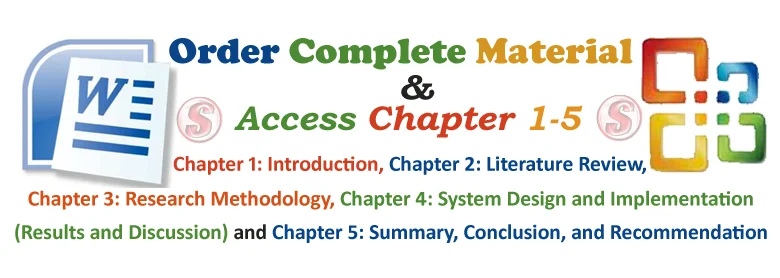1.1 Introduction
School examination timetabling system is a software application that will computerize and deal with the allocation of examination halls and time of a specific academic course of study. A timetable is the plan of lecture time and duration, lecture venue and lecture date between teachers and students in a prefixed time period (typically a week), satisfying a set of varying constraints. Timetables are crucial for lecture scheduling and proper allocation of resources such as time and venues for lectures or examinations. A perfectly planned timetable serves as a tool for aiding time management among individuals and organizations. This in turn leads to efficiency and positive outcomes in performances (Mathias, Abifarin & Imavah, 2019).
As a prelude to other parts of this study, this chapter will discuss the background upon which this study was initiated, the statement of problems that led to this study, the Aim and Objectives of the study. Others are Significance of the study, Scope of work, Limitation of the study and Definition of technical terms.
1.2 Background of Study
Every school year, institutions of education face the rigorous task of drawing up timetables that satisfies the various courses and their respective examinations being offered by the different department. The difficulty is due to the great complexity of the construction of timetables for lectures and exams, due to the scheduling size of the lectures and examinations periods and the high number of constraints and criteria of allocation, usually circumvented with the use of little strict heuristics, based on solutions from previous years (Jose, 2008).
The difficulties of developing appropriate examination time table for institutions and tertiary is increasing. Institutions are enrolling more students into wider variety of courses in many different fields. For example, at Osun State Polytechnic, Iree, approximately 14,000 students have to be filled into about 150 exams over two and a half week’s period. The examination timetable problem regards the scheduling for the exams of a set of polytechnic courses, avoiding overlaps of exams of courses having common students, and spreading the exams for the students as much as possible.
Examination scheduling (timetabling) is a very important process in education institutions. The main challenge is to schedule examinations to timeslots and rooms over a specific period while satisfying a set of constraints. The previous attempts were based on the graph coloring concept. In this case the vertices represent causes, and join two vertices only if they cannot be scheduled at the same time. The problem is therefore to find the chromatic number of resulting graph.
One of the major approaches in exam timetabling over the years has been constraint programming approach (Simulated Annealing). This method constraint programming logic language (chip) also to solve exam timetabling problem. Constraint programme phase provide an initial solution and a simulated annealing phase to improve the quality of solutions.
The local search approaches play an important role in the exam timetabling literature. White and Xie and Di Gaspero and Schaef used tabu search method in exam timetabling. White and Xie Kept two table lists, the used short-term table list, and the long-term tabu lists keeps tracks of the most moved exams, Di Gaspero and Scheaf used a single table list, but when exams are added to this list, its for a randomly determined number of iterations.
The polytechnic has two semesters per each academic year. Each semester per each academic year and each semester is made up of up to fifteen weeks of teaching, by followed by two weeks of examination. There are two examination sessions per day except on Saturday where student are allowed to rest and start of Sabbath for seventh day Adventist. Examinations are mostly three hours long with a few exceptions which deviates for half an hour or two hours.
There are an increasing number of courses which cut across facilities and polytechnics-wide courses which are offered to more than a thousand students at the same time. The problem is also complicated by the freedom of choices by students on optimal courses, where students have wide range of choices which cut across department and faculties.
The Examination Timetable Problem (ETP) is usually modeled as an NP-Hard (non-deterministic polynomial time hard problem) combinatorial optimization problem. The problem demands that a given number of exams are scheduled in a limited number of periods and venues in such a way that no student will have more than one exam at a time and other constraint are satisfied.
Although consideration will be based in particular on exams timetabling, the ideas presented here can be extended to many other application, which include not only other scheduling problems but also multi-criteria problems. In general, the reason to present an application to exams time tabling is justified by the affiliation of the auditors and their awareness of the increased difficulty that some recent strategies have introduced in this academic task. Just as an example monitoring the tendency forwards the flexibility of curricular and the increase of the number of students enrolled in each course.
1.3 Statement of Problem
Investigation revealed that the existing system has an improper examination timetable may result in students’ poor performance as it may not let them enough preparation between two sequential exams. In addition, there are many exams to be scheduled, large number of students who have taken different courses, the limited number of rooms or exam halls are available, and some constraints such as no conflict in a single student’s exams make it very difficult to schedule experimentally.
The generic algorithm phase to improve provides an initial solution and a simulated annealing phase to improve the quality of solution. The simulated annealing applies kempe chain neighborhood and includes a mechanism that allow the user to define a certain period of time in which the algorithm should run. The following are some of the specific challenges encountered in the Manual Process of Exam Timetable Scheduling;
- The current manually prepared exam time table is always error prone and takes a lot of time to reschedule.
- Manual system of planning and accessing this time table is stressful.
- Actual class sizes are not captured and as such there is error in Venue Allocation.
- Clashes in take place in cases of carryover students.
1.4 Aim and Objectives of the Study
The aim of the study is develop a Web Based School Examination Timetabling System that will be useful to our education institutions, using Generic Algorithms and simulated annealing. In achieving this aim, the following specific objectives were laid out as follows to design and implement a software that will:
- Explore study of Generic Algorithm and simulated annealing in resolving conflicts associated with exam timetabling;
- Automatically generate exam timetable using the two appropriate by considering Osun State Polytechnic exam time table data;
- Evaluate and compare the performance of the two algorithms in term of their computational complexity;
- Record and Store the actual sizes of the class and allocate venues accordingly; and
- Create a flexible and interactive Examination Scheduling Software that enables automatic generation of examinations schedules for tertiary institution in Nigeria.
1.5 Significance of Study
The significant of the research work is to assist to curb the examination timetable problems that may arise in the future, based on the following concussion and recommendation made by the researcher.
The finding of this study will enable us to understand and the importance of good examination timetable system for the tertiary institution easy and effective also with the used of appropriate examination timetable tom stimulate the timetable of various resources combination so as to encourage. better timetable planning and information gathering.
To minimize the length of examination period with the constraint given to used rate determine every student academic performance, give a technical knowledge and the competence of each student and also to allocate accurate time and venues.
1.6 Scope of Study
The scope of this research is focused on the Development of a Web Based School Examination Timetabling System using Generic Algorithms and Simulated Annealing. This proposed system is meant to cover examination time table scheduling for school of Industrial And Applied Science (SIAS) in Osun State Polytechnic, Iree.
1.7 Limitations of the Study
During the course of this study, many things militated against its completion, some of which are:
- Time Constraint: The time frame given to accomplish this project was very short due to school academic calendar and it was carried out under pressure which made the researcher not to implement some necessary features.
- Research material: availability of research material is a major setback to the scope of the study.
- Frequent power failure: This made the researcher append more money on fuel to ensure sustainable power.
- Financial Constraint: Insufficient fund tends to impede the efficiency of the researcher in sourcing for the relevant materials, literature or information and in the process of data collection (internet).
1.8 Definition of Terms
Exam:
An entrance examination offered the system, have some question and multiple choices answer.
Lay-men:
A person who is not a member a particular profession.
End-user:
A person that users a software developed by another person




